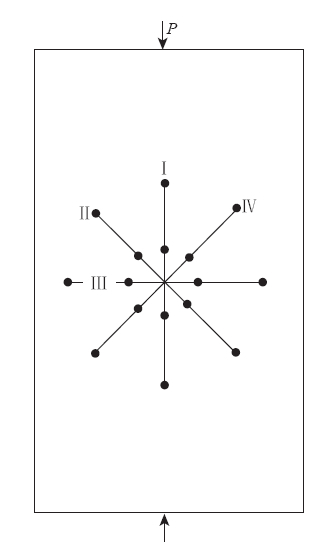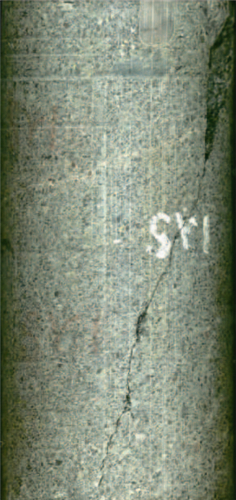Relation between directional characteristics of resistivity changes and principal stress
-
摘要: 介质电阻率变化的方向性与主应力方向的关系研究一直受到岩石电阻率实验和地震学等学科的关注. 本文在电极面4 cm×8 cm, 6 cm×12 cm, 8 cm×16 cm和4.6 cm×10 cm的10块分别为花岗岩、 凝灰质粗砂岩(夹砾石)和细晶花岗岩标本上及100 cm×100 cm的1块人工合成模型上, 采用对称四极法布设多位置、 多极距、 多方位电阻率测线, 用单轴压缩、 二维约束差应力压缩、 低围压三轴差应力压缩和真三轴差应力压缩方式加载. 其中在单轴压缩和低围压三轴压缩加载方式下, 7块岩石标本中的4块被压破, 3块没有被压破, 只压到电阻率出现明显的下降异常时卸压. 另在上述10块岩石标本中, 还有3块是电阻率原始各向异性标本. 将这样11块标本所获得的多位置、 多极距、 多方位测线电阻率资料, 按从开始加载到破裂的过程, 分成30%附近破裂应力段、 50%附近破裂应力段、 80%附近破裂应力段和100%破裂应力段, 研究同一测点多方位测道中该4个破裂应力段视电阻率变化最大(最小)幅度测线方位与力源最大主压应力方位的关系, 结果未发现二者之间有确定的关系.Abstract: Study on the relation between directional characteristics of resistivity changes and principal stress plays an important role in rock resistivity experiments and seismology. Using symmetrical four-electrode method, multi-position, multi-space and multi-direction resistivity arrays were arranged on 10 samples of granite, tuffaceous gritrock (with inclusion of gravel) and aplite granite, which have surface sizes of 4 cm×8 cm, 6 cm×12 cm, 8 cm×16 cm, 4.6 cm×10 cm, respectively, and 1 synthetic model of 100 cm×100 cm. The experiments were carried out with uniaxial, planar elastic constraint, low confining pressure and true triaxial compressions. In the uniaxial and low confining pressure tests, 4 of the 7 rock samples were loaded to rupture with macro-fractures, the other 3 were only loaded to the abnormal stage when resistivity began to decrease obviously. 3 of the 10 rock samples are samples of original resistivity anisotropy. According to the loading process from beginning to end, the resistivity data obtained from all of the 11 samples in the multi-position, multi-space and multi-direction resistivity arrays were divided into 4 rupture stress sections, namely, about 30%, about 50% and about 80% rupture stress sections and 100% rupture stress section. Thereby, the relation between directional characteristics of resistivity changes and principal stress corresponding to the 4 rupture stress sections is studied. However, the results show no confirmative relation between the two.
-
引言
一些学者有关地震震源机制的基本思想是,地震是由于地下断层某位置摩擦阻力较大,积累起弹性应力,当应力大过断层面上的摩擦阻力时,岩体发生快速错动所致,并认为这种地震前后,地球物理场的变化也直接或间接地与这种作用有关. 因此,寻找地下应力场与地球物理场变化的关系就至关重要,其对地球物理场变化的机理解释和地震预报实践指导具有重要意义.
地电学用于探索地震前兆和地震预报已有几十年历史. 为研究地电阻率与地震前兆的关系、 解释地电阻率的前兆机理,国内外学者做了大量室内外承载介质电阻率变化模拟实验研究,取得了许多有科学价值的成果(兰州地震研究所,1982; Kurite,1986; Teisseyre,1989; Stopin′ski,1992; 陆阳泉,温新民,1980; 陆阳泉等, 1988,1990a; 张同俊,1981; 赵玉林等,1983; 张金铸,陆阳泉,1983; 金耀等,1983; 陈大元等, 1983,1987; 张天中等,1985; 安金珍等,1996; 陈峰等, 1993,2000,2002,2003a,b). 但对于承载介质电阻率变化方向领域的研究还很不足,特别是国外学者实验采用的电阻率二极测量方法(Brace et al,1965; Brace,Orange, 1966,1968a,b; Brace,1975),不适宜研究承载介质电阻率变化的方向性. 因为电阻率二极测量方法测量的物理量是样品两个端面之间的平均真电阻率,它不能测量介质局部位置和多方位的电阻率变化,不能研究电阻率变化的方向性.
我国在研究介质电阻率变化的方向性与主应力方向之间的关系方面,做过许多研究工作(陆阳泉,温新民,1980; 陆阳泉等,1990b; 张同俊,1981; 陈有发,陆阳泉,1981; 陈大元等,1983; 陈有发,1993; 杜学彬等, 2006,2007; 杜学彬,2010),然而,由于实验资料不充足,实验样品布极和台站观测布极测线方向偏少,给研究工作带来了一些局限. 随着社会的进步与发展,地电实验工作也有了新的进展,在布极方法、 测量仪器自动化程度方面都有了很大提高. 本文利用我们承载介质电阻率实验中的压缩实验资料,研究电阻率变化的方向与最大主应力方向之间的关系.
1. 实验方法
为了获取电阻率各向异性测点,我们在标本上以测点为中心,用对称四极法布设互为45°角的4条电阻率测线,每个测点4条测线与最大主压应力的方向见图 1. 其中,侧线Ⅰ平行于最大主压应力方向; Ⅱ与最大主压应力方向的夹角为45°; Ⅲ垂直于最大主压应力方向; Ⅳ与最大主压应力方向的夹角为135°.
1)单轴压缩实验采用G5,G14和G22等3块长方体花岗岩标本,尺寸分别为6 cm×6 cm×12 cm,5 cm×8 cm×16 cm和4 cm×4 cm×8 cm. 3块标本的测线和测量功能组合、 布极图、 破裂图、 电极布设及标本处理方法见陈峰等(2000). G5标本没有被压破,只压到电阻率出现明显的下降异常时卸压,用显微照像才能看到标本的微裂隙. G14是原始电阻率各向异性标本,其4个电阻率测点对应的原始电阻率各向异性系数分别为1.28,1.20,1.12和1.38(陈峰等,2003a).
2)二维约束差应力压缩实验采用GT6,GT7和GT8等3块4 cm×4 cm×8 cm的长方体花岗岩标本. 3块标本实验的电极布设及标本处理方法、 约束方法和布极图见陈峰等(2002). GT6和GT7标本破裂图见图 2a,b.
3)低围压三轴差应力压缩实验采用Brgr1,Sr1,Rgr1和Rgr2等4块标本,其材质分别为花岗岩(Brgr1)、 凝灰质粗砂岩夹砾石(Sr1)和细晶花岗岩(Rgr1,Rgr2). 电极布设在4.6 cm×10 cm的弦切面上. 4块标本的形状和尺寸为5 cm×10 cm圆柱状切去4.6 cm×10 cm的弦切面的剩余部分. 实验相关的测线和测量功能组合、 布极图、 破裂图、 电极布设及标本处理方法和加载方法见陈峰等(2003a). Sr1标本破裂形态见图 2c; Rgr1和Rgr2标本没有被压破,只压到电阻率出现明显的下降异常时卸压,标本破裂形态见图 2d,e. 标本Brgr1和Sr1也是原始电阻率各向异性标本. Brgr1标本的原始电阻率各向异性系数为1.76(陈峰等,2003a). Sr1标本夹有大颗粒砾石不均匀含岩成分,并有一硅化岩屑凝灰岩脉穿过第Ⅲ方位测线的AM电极间、 第Ⅳ方位测线的MN电极间和第Ⅱ方位测线的NB电极间. 图 3是Sr1标本测量面的背面,该面没有涂绝缘胶,可见到标本含有砾石(砾石1和砾石2)和岩脉,并可见Sr1标本含岩成分不均匀.
4)真三轴差应力压缩实验采用人工合成大模型Big1,其尺寸为100 cm×100 cm×30 cm. 该模型的合成材料、 电极布设、 模型处理方法、 测线和测量功能组合及布极图与陈峰等(2003b)的Big5模型相同. 其加载方式为: σ3垂直于100 cm×100 cm的布极面,加载到压实,然后保持该面不变形; σ1平行于图 1的Ⅰ方向; σ2垂直于图 1的Ⅰ方向,且σ2=1/2σ1.
2. 资料处理方法
在研究电阻率变化的方向性与主应力方向之间的关系时,常用的方法为: 寻找同一测点多方向测道中电阻率变化最大(最小)幅度值测道的方向与力源最大主压应力方向间的关系,并由下式计算电阻率变化幅度值(陆阳泉等,1990b; 陈有发,1993):

式中,ρs max为最大测量值; ρs min为最小测量值; ρsi为第i次的测量值,i=1,2,3…; N为测量次数.
本文仍沿用上式进行资料分析,不同的是,我们不只用实验标本从开始加载到破裂全过程进行分析,而是将实验标本从开始加载到破裂过程分成4个破裂应力段进行分析处理. 4个破裂应力段分别为: 从开始加载到30%附近(因为某个电阻率测量值所对应的破裂应力不会刚好是30%,下同)、 50%附近破裂应力段、 80%附近破裂应力段和100%破裂应力段. 选择上述4个破裂应力段是基于如下考虑: 当实验标本加载到30%附近破裂应力段时,标本还未开始体积膨胀,电阻率变化不大; 当加载到50%附近破裂应力段时,标本开始体积膨胀并产生微裂隙,电阻率开始有较大变化; 当加载到80%附近破裂应力段时,标本产生微裂隙加速,电阻率出现大幅度变化; 当加载到100%破裂应力段时,标本出现大裂隙,甚至破裂毁坏. 最后的2个电阻率测值,可能已不满足电阻率测量理论需要连续介质的要求,因此,该破裂应力段对应处理的电阻率资料结果,应考虑最后2个测值可能的影响. 计算结果中的“-”号只表示电阻率变化是下降的,不表示电阻率变化幅度的大小.
3. 计算结果
表 1给出了资料处理分析的结果. 其中,单轴压缩G5标本大极距测点在30%附近破裂应力段,电阻率变化幅度最大的是Ⅳ测线方向; 在50%和80%附近破裂应力段,电阻率变化幅度最大的是Ⅰ测线方向; 但在100%破裂应力段,电阻率变化幅度最大的是Ⅱ测线方向. 小极距测点在30%附近破裂应力段,电阻率变化幅度最大的是Ⅲ测线方向; 在50%和80%附近破裂应力段,电阻率变化幅度最大的是Ⅳ测线方向,而在100%破裂应力段,电阻率变化幅度最大的是Ⅲ测线方向.
表 1 电阻率测点对应最大主压应力方位的4条测线的电阻率随破裂应力的变化幅度Table 1. Amplitude change of resistivity (per cent) as a function of rupture stress for the 4 measuring lines at measuring points relative to the orientation of the maximum compressive principal stress
单轴压缩G14标本左大极距测点,在30%,50%,80%附近和100%破裂应力段,电阻率变化幅度最大的都是Ⅰ测线方向; 而左小极距测点,4个破裂应力段上电阻率变化幅度最大的都是Ⅲ测线方向. 右大极距测点,在30%和50%附近破裂应力段,电阻率变化幅度最大的是Ⅳ测线方向; 在80%附近破裂应力段,Ⅱ和Ⅳ测线方向电阻率变化幅度最大,且相近; 在100%破裂应力段,电阻率变化幅度最大的是Ⅰ测线方向. 右小极距测点,4个破裂应力段上电阻率变化幅度最大的都是Ⅲ测线方向.
单轴压缩G22标本,在30%附近破裂应力段,电阻率变化幅度最大的是Ⅰ测线方向; 在50%和80%附近破裂应力段,Ⅰ和Ⅳ测线方向电阻率变化幅度最大,且相近; 在100%破裂应力段,仍是Ⅰ测线方向电阻率变化幅度最大.
二维约束差应力压缩GT6标本,在30%和50%附近破裂应力段,电阻率变化幅度最大的是Ⅰ测线方向; 在80%附近和100%破裂应力段,电阻率变化幅度最大的是Ⅳ测线方向. GT7标本,在30%和50%附近破裂应力段,电阻率变化幅度最大的是Ⅰ测线方向; 在80%附近和100%破裂应力段,电阻率变化幅度最大的是Ⅱ测线方向. GT8标本,在30%,50%和80%附近破裂应力段,Ⅱ和Ⅲ测线方向电阻率变化幅度最大,且相近; 在100%破裂应力段,电阻率变化幅度最大的是Ⅰ测线方向.
低围压三轴差应力压缩Brgr1标本,在30%,50%和80%附近破裂应力段,电阻率变化幅度最大的是Ⅰ测线方向; 在100%破裂应力段,电阻率变化幅度最大的是Ⅲ测线方向. 该标本在74.79%破裂应力后做蠕变实验,整个实验过程用恒定低围压,在92.3%破裂应力时又用恒定轴压,做蠕变实验58 min,测了11个电阻率数据; 在95.57%破裂应力时做蠕变实验,测了4个电阻率数据. 蠕变实验的电阻率变化幅度,包含在100%破裂应力段中.
低围压三轴差应力压缩Sr1标本,在30%,50%和80%附近破裂应力段,电阻率变化幅度最大的是Ⅱ测线方向; 在100%破裂应力段,电阻率变化幅度最大的是Ⅰ测线方向. Rgr1标本,在30%附近破裂应力段,电阻率变化幅度最大的是Ⅰ测线方向; 在50%和80%附近破裂应力段,电阻率变化幅度最大的是Ⅳ测线方向; 在100%破裂应力段,电阻率变化幅度最大的是Ⅲ测线方向. Rgr2标本,在30%,50%,80%附近和100%破裂应力段,电阻率变化幅度最大的都是Ⅳ测线方向.
真三轴差应力压缩人工合成大模型Big1,1—5号测点是小极距测点,其AB极距为31 cm; 6号测点,是大极距测点,其AB极距为76 cm. 表 2是该模型不同位置、 不同极距6个测点视电阻率随破裂应力变化的幅度值.
表 2 Big1大模型不同位置、 不同极距6个测点电阻率随破裂应力变化幅度Table 2. Amplitude change of resistivity (per cent) as a function of rupture stress at the 6 measuring points at different positions and spaces on the big model Big1
1号测点: 在30%附近破裂应力段,电阻率变化幅度最大的是Ⅲ测线方向; 在50%附近破裂应力段,Ⅱ和Ⅲ测线方向电阻率变化幅度最大,且相近; 在80%附近和100%破裂应力段,电阻率变化幅度最大的是Ⅱ测线方向. 2号测点: 在30%附近破裂应力段,电阻率变化幅度最大的是Ⅲ测线方向; 在50%,80%附近和100%破裂应力段,电阻率变化幅度最大的是Ⅳ测线方向. 3号测点: 在30%,50%,80%附近和100%破裂应力段,电阻率变化幅度最大的都是Ⅳ测线方向. 4号测点: 在30%和50%附近破裂应力段,电阻率变化幅度最大的是Ⅱ测线方向; 在80%附近破裂应力段,Ⅱ和Ⅳ测线方向电阻率变化幅度最大,且相近; 在100%破裂应力段,电阻率变化幅度最大的是Ⅱ测线方向. 5号测点: 在30%附近破裂应力段,电阻率变化幅度最大的是Ⅲ测线方向; 在50%附近破裂应力段,Ⅲ和Ⅳ测线方向电阻率变化幅度最大,且相近; 在80%附近和100%破裂应力段,电阻率变化幅度最大的是Ⅳ测线方向. 6号大极距测点: 在30%附近破裂应力段,电阻率变化幅度最大的是Ⅱ测线方向; 在50%附近破裂应力段,Ⅱ和Ⅳ测线方向电阻率变化幅度最大,且相近; 在80%附近和100%破裂应力段,Ⅰ,Ⅱ,Ⅲ和Ⅳ测线方向电阻率变化幅度都相近.
综上,同一位置两个不同极距测点的电阻率变化幅度最大的测线方向不一致; 同一测点4个不同破裂应力段,电阻率变化幅度最大的测线方向有一致的,也有不一致的; 同一标本不同位置、 不同极距测点,电阻率变化幅度最大的测线方向不一致,不同位置相同极距测点,电阻率变化幅度最大的测线方向有一致的,也有不一致的; 相同岩性、 相同尺寸、 相同标本处理和布极方法、 相同加载类型的不同编号标本的计算结果不相同. 上述结果表明,不同和相同尺寸的标本、 模型,不同和相同的布极方式,不同和相同的加载类型所得到的可比的测线中,电阻率变化幅度最大的测线方向与最大主压应力的方向之间没有确定的关系. 同样,表 1和表 2也显示,电阻率变化的极小值方向,也不都是指向最大主压应力方向; 在现有实验条件下,用电阻率变化幅度最大的测线方向确定最大主压应力方向的计算结果重复性差.
4. 讨论与结论
早期用电阻率变化幅度确定最大主压应力方向的研究中,由于当时电阻率测线布极方向偏少(仅3个),实验资料不充足,得到的实验结果有局限性,甚至存在彼此矛盾的现象. 例如,陆阳泉和温新民(1980)得到的结果是,“垂直于最大主应力方向的电阻率变化最大,平行于最大主应力方向的电阻率变化最小,与最大主应力成45°方向的电阻率变化居中”; 而张同俊(1981)却得到相反的实验结果: “平行于压力方向ρs减小量最大,垂直于压力方向ρs减小量最小”; 张金铸和陆阳泉(1983)中图 2的一个不同三轴应力实验结果表明,与最大主应力成45°方向的电阻率变化最大; 而吕广廷等(1984)中图 4的实验结果又显示: 平行于最大主应力方向的电阻率变化最大. 结合我们已做过的实验,陈大元等(1983)指出,“电阻率变化的最大方向并不都是平行于压力方向,而极小方向也不都是垂直于压力方向”.
陈有发(1993)总结了国内外地电实验方面的研究进展,认为“利用同点三向等极距地(视)电阻率法可以确定大地应力场方向. 地电阻率及其变化量的极小值方向都是指向主压应力场方向的”. 基于此,他认为,“根据京津唐张地区7.8级地震周围地电阻率前兆量小的方向,推断该地区主应力场方向,所得结果与京津唐张地区最大压应力场方向相差36°—98°(平均值51°左右),二者几乎没有重合部分”. 在当时实验台站布极偏少,实验资料欠缺的情况下,他把结果不符的最可能的原因归于“小尺度(视为均匀各向同性)岩石电阻率可能接近真电阻率”,“由各向异性奇象可知,受压岩石真电阻率变化极小值方向顺着主压应力方向,与地电阻率变化的极大值方向一致”(陈有发,1993),由此解释唐山7.8级地震地电阻率前兆现象. 现在看来,两者方向相差36°—98°如此之大的角度范围,用视电阻率各向异性奇象是很难解释的.
相反,杜学彬(2010)应用归一化变化速率方法(normalized variation rate method,简写为NVRM)研究了中国大陆27次MS≥5.5地震的孕震晚期阶段震中区及附近(相当于下降异常的集中范围)41个台的视电阻率变化,发现超过95%的台出现了与震源机制解最大主压应力(P轴)方位有关的视电阻率各向异性变化: 与P轴方位正交或近于正交的测道,显示快速、 大幅度的视电阻率变化; 沿P轴方位或近于该方位的变化幅度最小. 杜学彬(2010)和杜学彬等(2007)认为,这些震例表现的这种视各向异性变化与P轴方位的关系相当符合大多数含水岩(土)标本加载过程中视各向异性变化与最大加载方向的关系.
显然,上述两个用震例地电阻率变化确定的最大主压应力方向的结果是矛盾的. 因而,用电阻率变化最大(或最小)方向来确定最大主压应力方向的可靠性仍有待进一步验证. 本文中,考虑到岩石原始均匀各向同性标本,且测量值是真电阻率,我们结合G14和Brgr1两块非含岩成分电阻率原始各向异性以及Sr1一块含岩成分不均匀电阻率原始各向异性标本压缩实验的视电阻率资料进行分析. 结果表明,这些标本结果与其它标本无明显差别. 我们进一步考虑标本受小应力未开始体积膨胀和大破裂、 未破裂的情况,发现相关结果均无明显差异.
从电阻率变化的机制而言,虽然应力能引起介质电阻率的变化,但不能直接起作用,需通过介质裂隙的水网络导电通路才能发挥作用. 因此,只有介质的裂隙变化才直接与电阻率的变化有关. 而介质裂隙的方位与最大主压应力方位的关系并不是简单的对应关系,它与介质的结构、 材料力学性质有关,对于非均匀介质,情况非常复杂. 实际应用和理论探讨中,为了简单起见,往往忽略这类最重要的、 起关键作用的介质结构和材料力学性质问题,由此得到的理论结果与实际结果相差甚远,不能用来指导实际工作. 对这类比较复杂的问题,用实验检验是最好的方法. 实验中,介质裂隙的水网络导电通路变化引起不同位置、 不同方向测线电阻率的变化,利用这种变化就可以解释本文中用电阻率变化最大(或最小)方向来确定最大主压应力方向的结果为什么会杂乱无章,因为在不同或相同标本上,每条测线、 每个测点相对微裂隙变化的位置和方位是杂乱无章的. 也许有学者会提出,标本上测的是真电阻率,不是视电阻率. 由视电阻率各向异性奇象可知,真电阻率椭圆长轴与视电阻率椭圆长轴在方位角度上只相差90°,如果电阻率最大(最小)变化方位与最大主压应力方向间真有确定的关系,那么,无论测的是真电阻率还是视电阻率,就不会出现本文中电阻率最大(最小)变化方位与最大主压应力方向间杂乱无章的关系. 所以,不论用真电阻率或视电阻率最大(最小)变化方向,都不能较准确地确定最大主压应力方向. 地电阻率测量的优势就是能直接探测介质微裂隙的扩展方位和速率,但如何发展该优势,寻找到最需要的能较准确地确定最大主压应力方向的途径,还是一个艰巨的研究课题.
不同和相同尺寸的标本、 模型,不同和相同的布极方式,不同和相同的加载类型所得到的可比的多条测线中,没有发现电阻率变化幅度最大(最小)的测线方向与最大主压应力方向之间有确定的关系. 实验结果表明,用电阻率变化幅度最大(最小)的测线方向较准确地确定最大主压应力方向,还有待更深入的研究.
-
表 1 电阻率测点对应最大主压应力方位的4条测线的电阻率随破裂应力的变化幅度
Table 1 Amplitude change of resistivity (per cent) as a function of rupture stress for the 4 measuring lines at measuring points relative to the orientation of the maximum compressive principal stress

表 2 Big1大模型不同位置、 不同极距6个测点电阻率随破裂应力变化幅度
Table 2 Amplitude change of resistivity (per cent) as a function of rupture stress at the 6 measuring points at different positions and spaces on the big model Big1

-
安金珍, 修济刚, 陈峰, 陈大元. 1996. 单轴压力下有补给水岩石电阻率变化各向异性研究[J]. 中国地震, 12(3): 300-306. 陈大元, 陈峰, 王丽华. 1983. 单轴压力下岩石电阻率的研究: 电阻率的各向异性[J]. 地球物理学报, 26(增刊): 784-792. 陈大元, 陈峰, 贺国玉. 1987. 岩石受压过程中"应力反复"对电阻率的影响[J]. 地震学报, 9(3): 303-311. 陈峰, 陈大元, 曹其平, 于淑筠, 许东俊, 陈从新, 余毓良, 盛建豪. 1993. 原位岩体在剪切和摩擦滑动试验中的视电阻率变化特征研究[J]. 地震学报, 15(2): 217-223. 陈峰, 修济刚, 安金珍, 廖椿庭, 陈大元. 2000. 岩石电阻率变化各向异性与微裂隙扩展方位实验研究[J]. 地震学报, 22(3): 310-318. 陈峰, 廖椿庭, 安金珍. 2002. 弹性约束承载岩石电阻率变化形态研究[J]. 北京大学学报自然科学版, 38(3): 427-430. 陈峰, 安金珍, 廖椿庭. 2003a. 原始电阻率各向异性岩石的电阻率变化各向异性[J]. 地球物理学报, 46(2): 271-280. 陈峰, 廖椿庭, 安金珍. 2003b. 剪切和摩擦滑动大模型的视电阻率变化幅度和各向异性[J]. 地球物理学报, 46(5): 667-675. 陈有发, 陆阳泉. 1981. 地电阻率年变化的方向性与中国大陆构造应力场[J]. 地震学报, 3(1): 32-40. 陈有发. 1993. 受压岩石电阻率的方向性及其在地震预报中的应用[J]. 华南地震, 13(3): 1-8. 杜学彬, 马占虎, 叶青, 谭大诚, 陈军营. 2006. 与强地震有关的视电阻率各向异性变化[J]. 地球物理学进展, 21(1): 93-100. 杜学彬, 李宁, 叶青, 马占虎, 闰睿. 2007. 强地震附近视电阻率各向异性变化的原因[J]. 地球物理学报, 50(6): 1802-1810. 杜学彬. 2010. 在地震预报中的两类视电阻率变化[J]. 中国科学: 地球科学, 40(10): 1321-1330. 金耀, 张天中, 华正兴, 徐明发, 黄平章. 1983. 单轴压缩下多裂隙含水岩样电阻率变化与体积应变[J]. 地震学报, 5(1): 99-105. 兰州地震研究所. 1982. 国外对地电阻率法预报地震的研究[M]. 兰州: 兰州地震研究所: 1-250. 陆阳泉, 温新民. 1980. 三向压缩下大型混凝土标本的电性特征[J]. 西北地震学报, 2(4): 55-60. 陆阳泉, 钱家栋, 刘建毅. 1988. 砂岩在摩擦滑动中的电阻率变化及其在地震预报中的应用[J]. 西北地震学报, 10(3): 53-56. 陆阳泉, 钱家栋, 刘建毅. 1990a. 大型花岗岩标本缓慢膨胀破裂过程中电阻率和声发射前兆特征的实验研究[J]. 西北地震学报, 12(2): 35-41. 陆阳泉, 王玉祥, 温新民. 1990b. 受压岩(土)体电阻率变化的原地实验及大地震前后地电异常的初步分析[G]//第二届构造物理学术讨论会文集. 北京: 地震出版社: 158-168. 吕广廷, 赵广堃, 谢原定, 金铭, 蒋续媛. 1984. 应力作用下层状砂岩电阻率的变化特征[J]. 西北地震学报, 6(1): 11-16. 张金铸, 陆阳泉. 1983. 不同三轴应力条件下岩石电阻率变化的试验研究[J]. 地震学报, 5(4): 440-445. 张天中, 华正兴, 徐明发. 1985. 1.2千巴围压下岩样破裂和摩擦滑动过程中电阻率变化[J]. 地震学报, 7(4): 428-433. 张同俊. 1981. 矿井岩层受力状态与视电阻率关系的实验研究[J]. 西北地震学报, 3(1): 1-24. 赵玉林, 钱复业, 扬体成. 1983. 原地电阻率变化的实验[J]. 地震学报, 5(2): 217-225. Stopin'ski W. 1992. 用电阻率测量法检测在加载条件下介质的动力过程[J]. 地震学报, 14(2): 220-228.
Brace W F, Orange A S, Madden T R. 1965. The effect of pressure on the electrical resistivity of water-saturated crystalline rocks[J]. J Geophys Res, 70(22): 5669-5678.
Brace W F, Orange A S. 1966. Electrical resistivity changes in saturated rocks due to stress[J]. Science, 153(3743): 1525-1526.
Brace W F, Orange A S. 1968a. Electrical resistivity changes in saturated rocks during fracture and frictional sliding[J]. J Geophys Res, 73(4): 1433-1445.
Brace W F, Orange A S. 1968b. Further studies of the effect of pressure on the electrical resistivity of rocks[J]. J Geophys Res, 73(16): 5407-5420.
Brace W F. 1975. Dilatancy-related electrical resistivity changes in rocks[J]. Pure Appl Geophys, 113(1-2): 207-217.
Kurite K. 1986. How can we identify location of a fracture plane? Anisotropy of electrical conductivity and seismic velocity in dilatancy[J]. Earthq Pred Res, 4(1-2): 39-45.
Teisseyre K. 1989. Anisotropy of electric resistivity related to crack processes before fracturing[J]. Acta Geophys Pol, 37(2): 185-192.
-
期刊类型引用(24)
1. 孙君嵩,王丽,袁桂平,章鑫,李鸿宇. 2021年漾濞M_S6.4地震地下面电流计算研究. 大地测量与地球动力学. 2025(01): 91-96 .  百度学术
百度学术
2. 刘海洋,艾萨·伊斯马伊力,徐衍刚,韩时雨. 2020年伽师M_S6.4地震前柯坪台地电阻率数据变化分析. 内陆地震. 2024(03): 273-280 .  百度学术
百度学术
3. 解滔,卢军. 地电阻率观测常见变化形态及其可能原因分析. 中国地震. 2023(01): 128-142 .  百度学术
百度学术
4. 解滔,卢军. 中国中强地震前地电阻率中短期异常特征及其可能原因. 中国地震. 2023(01): 45-63 .  百度学术
百度学术
5. 于晨,卢军,解滔,刘长生. 2017—2019年松原地区4次中强地震前绥化台地电阻率异常分析. 中国地震. 2023(02): 314-324 .  百度学术
百度学术
6. 张明东,刘建波,张玮,吴博洋,廖晓峰. 天津塘沽台直流视电阻率下降异常的成因分析. 地震学报. 2023(04): 671-684 .  本站查看
本站查看
7. Guoze ZHAO,Xuemin ZHANG,Juntao CAI,Yan ZHAN,Qinzhong MA,Ji TANG,Xuebin DU,Bing HAN,Lifeng WANG,Xiaobin CHEN,Qibin XIAO,Xiangyu SUN,Zeyi DONG,Jijun WANG,Jihong ZHANG,Ye FAN,Tao YE. A review of seismo-electromagnetic research in China. Science China(Earth Sciences). 2022(07): 1229-1246 .  必应学术
必应学术
8. 姜楚峰,吴迎燕,冯志生,戴勇,孙君嵩,章鑫,冯丽丽,李军辉. 短期线状集中分布地磁日变化感应电流异常机理初步解释——以2012年唐山4.8级地震为例. 中国地震. 2022(02): 226-238 .  百度学术
百度学术
9. 倪晓寅,陈莹,杨锦玲. 地磁逐日比异常电磁学成因的进一步分析. 中国地震. 2022(02): 239-247 .  百度学术
百度学术
10. 戴勇,冯志生,吴迎燕,姜楚峰,孙君嵩,章鑫,冯丽丽,李军辉. 地磁日变化感应电流异常与地震的成组特征初步分析. 中国地震. 2022(02): 199-212 .  百度学术
百度学术
11. 赵国泽,张学民,蔡军涛,詹艳,马钦忠,汤吉,杜学彬,韩冰,王立凤,陈小斌,肖骑彬,孙翔宇,董泽义,王继军,张继红,范晔,叶涛. 中国地震电磁研究现状和发展趋势. 中国科学:地球科学. 2022(08): 1499-1515 .  百度学术
百度学术
12. 解滔,于晨,王亚丽,李美,王中平,姚丽,卢军. 2013年岷县-漳县M_S6.6地震前通渭台的视电阻率变化. 地震地质. 2022(03): 701-717 .  百度学术
百度学术
13. 朱涛. 地震电阻率实验研究新进展及展望. 地球与行星物理论评. 2021(01): 61-75 .  百度学术
百度学术
14. 解滔,卢军. 含裂隙介质中的视电阻率各向异性变化. 地球物理学报. 2020(04): 1675-1694 .  百度学术
百度学术
15. 解滔,王同利,肖武军,胡毅涛,李然,卢军. 2020年7月12日唐山M_S5.1地震前通州台井下地电阻率变化. 中国地震. 2020(03): 375-382 .  百度学术
百度学术
16. 解滔,卢军. 横向不均匀性对视电阻率各向异性变化的影响和地震前电阻率的变化深度. 地震地质. 2020(05): 1172-1187 .  百度学术
百度学术
17. 王建国,李玮,张世珍. 岩矿含水率对电阻率的影响及对矿山突水预测的意义. 有色金属(矿山部分). 2019(05): 105-110 .  百度学术
百度学术
18. 张斌,朱涛,周建国. 岩石电阻率图像及各向异性变化的实验研究. 地震学报. 2017(04): 478-494+633 .  本站查看
本站查看
19. 张迪,魏大勇,许进鹏. 恒源煤矿太灰疏放对陷落柱活化导水影响的监测预警. 煤炭技术. 2017(10): 19-23 .  百度学术
百度学术
20. 刘素珍,李自红,张淑亮,殷志刚,李宏伟,王霞. 2014年大同地电阻率NW测向异常分析. 地震地磁观测与研究. 2016(02): 104-110 .  百度学术
百度学术
21. 张斌,周建国. 岩石电阻率的实验研究. CT理论与应用研究. 2015(02): 239-249 .  百度学术
百度学术
22. 赵国泽,王立凤,詹艳,韩冰,肖骑彬,陈小斌,汤吉,蔡军涛. 地球交变电磁场法应用研究新进展. 工程地球物理学报. 2014(03): 271-276 .  百度学术
百度学术
23. Xie Tao,Lu Jun,Ren Yuexia,Zhao Minyuan. Analysis on Apparent Resistivity Variations of Garzê Station before the 2013 Lushan M_S 7. 0 Earthquake. Earthquake Research in China. 2014(03): 388-402 .  必应学术
必应学术
24. 解滔,卢军,任越霞,赵民渊. 2013年芦山M_S7.0地震前甘孜台地电阻率变化分析. 震灾防御技术. 2013(04): 377-388 .  百度学术
百度学术
其他类型引用(9)





 下载:
下载:


